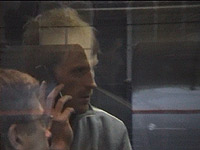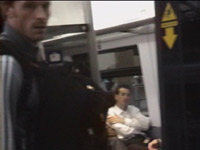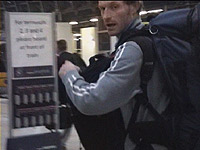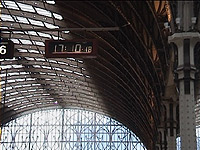| CHRIS HELSON | ||||
|
THE ACT
|
Interview | |||
      |
Toni Roig interview with Chris Helson September 2002.
Entrevista de Toni Roig a Chris Helson. Toni Roig is the Director of Media Studies at the The Virtual University, Universitat Oberta de Catalunya. TLT - What was the importance that the web site resources had for the project? I'll try to elaborate the question. I'd like to know if you thought from the beginning of the process of planning the project that the web site would be of such an importance, especially as a way to contextualize and narrate through different sources and media ( emails, stills, edited and live video, maps, text...), after the transmission. I think it was an essential narrative resource of the exploration trip going on and that The act can only be fully understood through all this web resources, but I don't know if that was the idea or if you thought that the core of the Act would be the live transmission. Furthermore, I've read that some of the artists underrated the importance of the web archive and the other site pages after the transmission. What did you think about that? CH - The Act was primarily a web based work and was shown in it's entirety within the context of the site. For me, the core of the work was a process that explored the tension between television and the web, rather than any single element or outcome. In terms of the context in which the work would be seen, the commission was for a web based project. However, because of the different content, scale and context in which the projects were realised, the significance of the web site ( as opposed to the web cast) became more or less important to each artist. In making The Act, my revealing the process was at the centre of the idea, so from the outset my intention was to use the web site as both a multilayered context to show process and an opportunity to explore and question the medium. With regard to audience I was particularly interested in exploring the differences in interface, the web being more intimate, active, multilayered and personal, TV traditionally passive and often viewed as a shared experience. TLT - It seems to me that The act began (in a critical way) as a project in the news genre, but it evolved into a kind of ethnographic project. Would you agree in that? If so, was it planned? CH - The idea: 'At the time of the TV swansong launch, Helson will travel to the next site chosen by international rolling news networks as the top story' defined the core structure of the project. In terms of the way in which the project was perceived the idea of the specific news story or rather the possibility ( Where will he go? Where would it be today?) allowed people to engage with the idea, the reality for me was that the type of story became of prime significance. And their are many different types of news story, as I write this BBC World's three top stories are all reports of speeches concerning different lands in conflict: President Bush speech about Iraq, President Putin speech about Chechen rebels In Georgia and Mullar Omar statement about Afghanistan. In terms of 'international' 24 hour rolling news during the lead up to 20-03-02 the top stories predominantly concerned the Palestinian / Israeli conflict, often describing: (1) a specific event ( for example, a suicide bomb) usually treated by the media as short term rolling news (dash to the scene) with the possibility of later more specific reporting, (2) a statement or meeting involving significant people, often reported from in front of the significant building following a press conference, (3) a longer term event focusing on a particular location ( for example, The Jenin Refugee Camp or the Church of the Nativity) a complex news situation where the devices used by the media become much more multilayered. Obviously their are many other types of story, I offered these examples to illustrate my thinking. Through my research I identified a number of key elements that I wanted to explore through the making of The Act: soon-to-be-famous place, simulation and iconography within the constructed media frame, breaking story, real time, predictions, use of experts etc. The Corihuayrachina news story broke at lunch time on 19-03-02, was treated as top story by BBC World and contained many of the elements that I had been researching. I had however expected to go to a news story where the media were or had been present, and I had (following the events of 9/11) expected that it would have been directly linked to 'The war on terror' ( see attached email dated 10-04-02). The Act, as it's name suggests was a piece of theatre and simply an action, in making it I wanted to reveal the reality/ unreality of international news reporting and the media space created or re-created. The Act was not an ethnographic project, it did not attempt to explain the subject of the story, the history or archaeology of the site, or the culture of the Incas or of the people we met or travelled with. TLT - It seems that there has been a mistake in the TVSS website, as in the archive it is no possible to see The act part 2. What you can see then is the edited version of The act. Could you remind me please what was included in the second webcast? CH - Act 2 originally showed the footage from Lima with me talking to Miriam whom I had just met about how to get to the site. We were seated in the foyer of a hotel looking at maps. The original act 2 is on the site here . The edit of the journey has replaced act2 simply because so many people were visiting the archive to watch. Karen and Nina requested that Act 2 be replaced in order to show the edited walk on a high bandwidth resolution. TLT - Watching the videos and reading the information, it is obvious that you have a pretty good idea of what you were going to do. In which sense the project has become different that you thought? CH - In February I wrote ' I imagine an extreme place, where people are frightened or excited or angry or hurt or free or happy or lost or dead. And in building a generic kit I begin to make a reality.' so I had expected that the media space would have been created by, or in some way dependant upon, the activity of people there. I had also expected that, as top story on BBC World, the media would have been present or at the very least had been there at all. In media terms it was a virtual space. I had anticipated that the media frame would have been constructed with iconographic images but was surprised at the blatant use of false images. The reality of the project was a surprise. Although I don't see any one element at the core of The Act, their was at the centre of the project the moment of decision in London. I had spent 18 months of research and preparation to arrive at the reality of the key question, where will he go? With the international news having been dominated by the Palestinian/ Israeli conflict for weeks before 20-03-02, on the afternoon of the 18th I booked provisional flight tickets to Tel Aviv for the morning of 20-03-02, intending to travel on to Jerusalem by taxi, with the expectation to stop outside Jerusalem to web cast Act 1. At lunchtime on the day before the web cast, I checked the CNN and BBC World top stories. They were 'Peru's new Machu Picchu' The discovery of Corihuayrachina and 'Cheney offers olive branch to Arafat' http://news.bbc.co.uk/2/hi/world/middle_east/1880832.stm ( this story now shows as having been written on 20 March 2002 and may be incorrectly dated or have been updated?) For about an hour we tried to get a flight to Peru and eventually found one that would get us to Chile in time to web cast, we held it for one hour, again checking the news. Nina, Karen, Georgia, Sarah and I stood in the office and discussed the implications of both stories in terms of the project I had written and the outcome of months of research. I think at that point the project team started to panic a little about the physical dangers involved in either journey, we had for months discussed the potential dangers, but that was the moment and no longer the idea of the moment. The Cheney/ Arafat Story was speculative, no place or meeting was defined, although it fitted well with the research I had done and it was likely that after the initial travel I would be based in one place, with a chance to really begin to understand the space. The Peru story was simple, a soon-to-be-famous-place, an icon, but described by the media as having been reached after an expedition '2 years in the planning' so their was the risk that we might not get there, also it meant that we would be travelling for the entire 12 days and I was concerned about how that would impact on the project. Eventually, I went outside and walked round the car park calmed myself down and made the decision. At which point we bought the tickets, had them bicycled to the airport, and had two hours to get to Heathrow, which was an hour away, and we had to pack and go to the health centre first to check our Malaria cover . I had thought that 'where will he go?' was a simple idea that would engage people with project, by the time the moment arrived the idea had become so self contained that it didn't matter what the story was. In one sense the project was all about that moment reading the news. As for the video: TLT - Why have you refused to use voiceover or subtitles in the video? CH - The Act was an absurd exploration of the reality/ unreality of news media space, their was no need for explanation or translation. I wanted the viewer to watch the images and listen to the sounds. TLT - Your presence in front of the camera in the edited version of the Act seems to be secondary. Why? What do you think are the functions of your presence as a subject in the video? CH - This news media space was quiet and peaceful, no media were there and no one apart from Washy talked much. The Act was my journey to and in that space, I was exhausted and dizzy from high altitude, I like the lunch, the rain and the mountains was part of what made up that space. I did set up one shot during the live web cast 'the archetypal correspondent framed shot with backdrop' in which I didn't talk, which referred to the promo video that I had made, the email that came as we broadcast live from Nina said simply ' we can see you, but we can't hear you. TLT - Why have you only use footage of the journey through the mountains and not, for example, about the preparation for the journey? CH - Initially, I saw The Act as a web based project and intended to use video streaming only. When I returned, it became clear that because of the nature of the footage in the mountains (both sound and images) that a large screen high quality format version of that part of The Act would offer a different insight of the project. TLT - An audience that only experimented the video of The act would lose all the dimension of the critic to the process of newsmaking. Do you think that anyway the core of The act is in the video or The act must be in fact everything (video, background information, links, emails, live webcasting..._)? Are there any boundaries? CH - The video is not self contained and is only shown in context to the site or an event like the TV Swansong Symposium. And anyone who would like a copy can contact me through the web site. The core of The Act is the act. Making the flight (real video 56k) |
|
||
|
|
||||
|
|
||||
| TOP | ||||